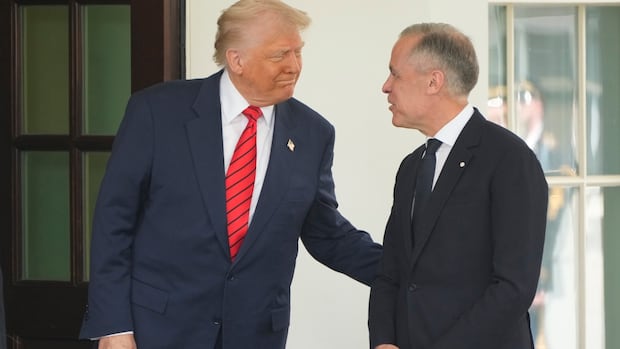[
In a sign that Canada and the U.S. are making progress toward some sort of trade agreement, CBC News and Radio-Canada have learned about the existence of a working document outlining details of a potential deal.
According to three sources with direct knowledge of the situation, the document has been sent back and forth between Ottawa and Washington. The sources spoke to CBC on condition they not be named because of the sensitivity of the matters being discussed.
Although this is considered a step toward the overall goal of reaching a deal, there are warnings from multiple sources that more work needs to be done before there’s an agreement.
In a sign that Ottawa and Washington are making progress toward some sort of trade agreement, CBC News and Radio-Canada have learned about the existence of a working document outlining details of a potential deal.
Two sources said there is no expectation a deal will be reached before the G7 summit in Alberta next week.
“There’s no deal agreed upon by both countries,” said a fourth Canadian government official speaking on background.
“In a negotiation, there will be many documents sent back and forth with several hypothetical scenarios,” the official said.
CBC News has not seen the document, but one source with direct knowledge of the situation tells Radio-Canada that it is fewer than five pages.
The source says it states that Canada is willing to participate in the Golden Dome security program, originally proposed by U.S. President Donald Trump.
It also mentions Canadian commitments to build more infrastructure in the Arctic, Canada’s pledge to meet its NATO defence spending targets, as well as previously announced border security investments.
Irritant in Canada-U.S. relationship
Canada’s contributions to national and global security have become an irritant in the Canada-U.S. relationship, with Trump accusing Canada of not doing enough.
It remains unclear what the American side is willing to commit to, although Canada has lobbied aggressively for tariff relief.
The U.S. has imposed a wide range of tariffs on Canadian exports, although many carveouts and exceptions have been added.
There are 25 per cent tariffs on all Canadian goods and 10 per cent tariffs on Canadian energy, imposed by Trump, citing his concerns about security along the border, and the flow of fentanyl into the U.S.
However, there are carveouts for products that are compliant with the Canada-U.S.-Mexico Agreement, known as CUSMA.
There are tariffs related to the auto sector, with again more carveouts for goods that qualify under CUSMA.
At Issue this week: Sources tell CBC/Radio-Canada that Carney and Trump have shared private calls and texts about tariffs. Premiers pitch their infrastructure projects to the prime minister. And does a new border security bill go too far?
Trump also upped tariffs on steel and aluminum for nearly all U.S. trading partners to 50 per cent from 25 per cent last week.
CBC News has asked the White House, the U.S. Trade Representative’s office and the U.S. Department of Commerce for comment, but they declined to respond on the record.
Setting expectations
A second source with direct knowledge of the situation told CBC News this is a very tumultuous moment in the Canada-U.S. relationship, but that generally trade negotiations are moving in a positive direction.
The source said these are not traditional trade talks as Canadians witnessed during the renegotiation of the North American Free Trade Agreement (NAFTA), which is now known as CUSMA.
CUSMA is up for review next year, but both Canadian and U.S. officials have signalled that they are open to starting that process sooner.
Comprehensive trade negotiations tend to be far more technical than the broad conversations taking place in this moment.
The Trump administration has been engaging with dozens of countries, including Canada, to reset its trading relationships all over the world, aiming to change terms to favour American workers and businesses.


